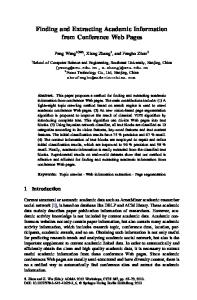Extracting information from European analyst forecasts
- PDF / 132,743 Bytes
- 10 Pages / 595 x 765 pts Page_size
- 22 Downloads / 361 Views
Andrea S. Au is a quantitative research analyst at State Street Global Advisors’ Advanced Research Center in Boston, Massachusetts, USA. State Street Global Advisors, Boston, Massachusetts, USA. Tel: þ 1 617 664 9962; Fax: þ 1 617 664 6133; E-mail: [email protected]
Abstract The impact of analyst forecasts is undeniable. However, previous research on analyst factors yields either event strategies that are unimplementable or consensus strategies whose effectiveness has diminished. My analysis looks at independent and combined effectiveness of consensus, dispersion, and an untested revision measure for earnings, recommendations, and price targets in the European market. My results suggest that investors designing an analyst trading strategy should look beyond earnings or recommendations alone and include measures other than simple consensus. Journal of Asset Management (2007) 8, 228–237. doi:10.1057/palgrave.jam.2250076 Keywords: security analysts, earnings, recommendations, price targets
Introduction Analyst forecasts have been proven to have an impact on market returns,1 and thus play a significant role in the formation of investment decisions. Although there are a plethora of studies on the market reaction to analyst forecasts, most do not provide feasible strategies for investors. Even if an investor were able to determine which analysts have the most market impact, he probably would not have the time to follow and internalise what these analysts are forecasting for more than a handful of securities. A realistic trading strategy might involve forecasts from multiple analysts at a point in time. A common substitution is to use consensus earnings estimates or recommendations. Generally, however, information contained in consensus earnings estimates is efficiently reflected in share prices.2 In addition, although a US study by Barber et al. (2001) finds that an investment strategy based on consensus recommendations earns positive returns,
228
Jegadeesh et al. (2004) show that this is only true for stocks with other favourable quantitative characteristics. To the best of my knowledge, there are no published studies on the effect of consensus price targets on returns. Another known measure is analyst dispersion. Analysts’ forecast dispersion generally refers to the disagreement among analysts with regard to an expected forecast of a given firm. Previous research presents conflicting results for the relation between earnings dispersion and future returns. Conclusions from previous research, all of which focused on earnings dispersion, conflict with regard to the ability of these dispersion measures to form profitable trading strategies. On the one hand, there are a handful of studies that provide some evidence of a positive association between analyst earnings dispersion, as a proxy for divergence of opinion, and future stock returns.3 These findings are consistent with theories on
Journal of Asset Management Vol. 8, 4, 228–237 & 2007 Palgrave Macmillan Ltd, 1470-8272 $30.00 www.palgrave-journals.com/jam
Extrac
Data Loading...











